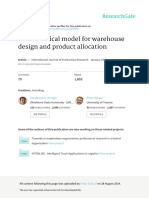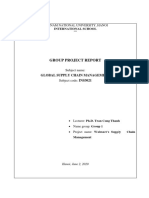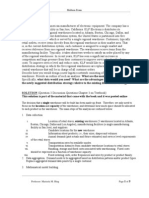Assignment 2
Uploaded by
Thiện DuyAssignment 2
Uploaded by
Thiện DuyAssignment 2
I. PROBLEM INTRODUCTION
Product distribution in a supply chain is an importation operation in today business’ intense competition. One
of the key decisions is product allocation in a distribution network, which affects its competiviveness because
proper allocation leads to efficiency in satisfying customer demand. This study involves a case study of
designing a distribution network of a company in Thailand. The network structure is shown in Figure 1.
Fig.I. Distribution network
Figure 1 illustrates the network under study, which consists of one factory, one internal warehouse, three
external warehouses and many customers, domestic and oversea. The factory has a production capacity of
250,000 mt per year, and has its dedicated internal warehouse with storage capacity of 20,000 mt. Due to the
limited capacity of the internal warehouse, the company currently uses three externally rent warehouses, two
small (located closer to the factory) and one large, all of which charge storage cost on a per unit per period basis.
Customers can be divided into domestic customers in more than fourty provinces of Thailand and a group of
oversea customers, whose delivery destination is the largest seaport of Thailand.
Products vary by level of quality and are packed in six different package sizes and types. There is a total of
91 products resulting from unique combinations of quality level and package type. Customer demands can be
satisfied by direct shipment from the internal warehouse or by inventories stored at the external warehouses,
which require product to be transferred from internal to external warehouses.
Future customer demand mixes between domestic and oversea are forecasted for a period of three years, from
2018 to 2020 (Figure 2). As seen from the figure, domestic demands are expected to slightly increase for the
next two years (2018-2019), and grow in the third year (2020). In contrast, oversea demands are forecasted to
decrease slightly for the next few years (2018-2019), and decrease relatively higher in the third year (2020).
Fig.II. Customer demand
Product movement is simply divided into fast moving and slow moving. Table 1 shows the number of SKUs
and average inventory days of the products.
TABLE I
AVERAGE INVENTORY DAYS OF FAST AND SLOW MOVING PRODUCT
Factory
No. of SKU 12
Fast moving
Avg. Inv. Day 10.5
No. of SKU 79
Slow moving
Avg. Inv. Day 53.8
2
The warehouse operations, both internal and external, include packaging, inbound loading and unloading with
forklift or labor, putaway, storage, retrieval, and outbound loading and unloading. At internal warehouses, all
products are delivered from factory for packaging first, Then, products are either stored at the internal
warehouse, or transferred to one of the external warehouses. For transferred products, they will be packed,
wrapped, and loaded before transfering. The products to be delivered to the customers, at both internal and
external warehouses, are retrieved from storage, picked, wrapped, load and unload on to delivery trucks.
There are three types of storages that require different storage areas in the warehouses: normal package and
large package are block stacked in conventional storage areas, and some special products are kept in tent.
Products and storage areas are preassigned according to the product quality level, package type, and value.
These storage types must be taken into account, when considering the warehouse capacity.
There are six modes of transportation: two types of 10-wheel trucks, two types (sizes) of 18-wheel trucks,
bulk truck, and pipe. They are used to deliver products from factory to warehouses (pipe and 10-wheel truck),
from warehouses to domestic customers (bulk truck and 10-wheel trucks), and from warehouses to oversea
customers (18-wheel trucks).
To efficiently meet future customer demand, an important decision is to find optimal product allocation in this
network: from factory to each warehouse and from each warehouse to the customers. The objective is to
minimize the total cost, consisting of transportation and warehouse costs, over the period of planning horizon. A
mixed integer linear programming (MILP) model is developed to find optimal solution of this problem.
II. MATHEMATICAL MODEL
Some notations are used for the mathematical formulation of model.
A. Sets
p : product, which are defined uniquely by qulity level and package type.
e : external warehouse.
o : oversea customer.
d : domestic customer.
t : time period.
m : transportation mode.
opi : operations in internal warehouse.
ope : operations in external warehouse.
opt : operations for transferring products from internal warehouse to external warehouses.
k : storage type.
M IO = {5, 6}: Transportation mode set from internal warehouse to oversea customers.
M EO = {5, 6}: Transportation mode set from external warehouses to oversea customers.
M ID = {2, 3, 4}: Transportation modes from internal warehouse to domestic customers.
M ED = {2, 3}: Transportation modes from external warehouses to domestic customers.
M DD = M ID M ED : Transportation modes from internal or external warehouses to domestic customers.
M OD = M IO M EO : Transportation modes from internal or external warehouses to oversea customers.
P = {1, 2, 3, .., 91} : All product set.
T = {1, 2, 3} : Time period set.
E = {1, 2, 3} : External warehouse set
D = {1, 2, 3, .., 44} : domestic customer set.
A = {1, 2, 3,.., 8} : all warehousing operation set at internal warehouse.
B = {3, 5, 6, 9, 10, 11} : all warehousing operation set at external warehouses.
C = {1, 4, 5, 6, 10} : all warehousing operation set of transferring from internal warehouses to external
warehouses.
K = {1, 2, 3} : storage type set.
B. Parameters
CFIt : Unit transportation cost from factory to internal warehouse in period t.
CIEe ,t : Unit transportation cost from internal warehouse to external warehouse e in period t.
CIOm ,t : Unit transportation cost from internal warehouse to oversea customer using mode m in period t.
CEOe, m ,t : Unit transportation cost from external warehouse e to oversea customer using mode m in period t.
CIDd , m ,t : Unit transportation cost from internal warehouse to domestic customer d using mode m in period t.
3
CEDe , d , m ,t : Unit transportation cost from external warehouse e to domestic customer d using mode m in period t.
Copi : Unit cost of performing all warehousing operations for products stored at internal warehouse.
Cope , e : Unit cost of performing all warehousing operations for products stored at external warehouse e.
Copt : Unit cost of performing all warehousing operations of for products transferred from internal warehouse to
external warehouse e.
CAPe , k : Warehouse capacity at external warehouse.
CAPI k : Warehouse capacity at internal warehouse.
I p : Inventory day of product p.
DDd , p , m ,t : Domestic customer d demand of product p using mode m in period t.
OD p , m ,t : Oversea customer demand of product p using mode m in period t.
FCap p ,t : Amount of products p supplied from factory in period t.
C. Decision variables
XFI p ,t : Flow of product p from factory to internal warehouse in period t.
XIEe , p ,t : Flow of product p from internal warehouse to external warehouse e in period t.
XIOm , p ,t : Flow of product p from internal warehouse to oversea customers using mode m in period t.
XEOe , m , p ,t : Flow of product p from external warehouse e to oversea customers using mode m in period t.
XIDd , m , p ,t : Flow of product p from internal warehouse to domestic customers d using mode m in period t.
XEDe , d , m , p ,t : Flow of product p from external warehouse e to domestic customers d using mode m in period t.
Yp ,t : Amount of products p stored at internal warehouse in period t.
Ye, p ,t : Amount of products p stored at external warehouse e in period t.
Z p ,t : Amount of products p transferred from internal warehouse in period t.
Sk ,t : Total storage space of storage type k at internal warehouse in period t.
Se , k ,t : Total storage space of storage type k at external warehouse e in period t.
III. QUESTION:
Based on the information in parts I and II, build a mathematical model
(Hint: The mathematical model includes an objective function that minimizes total costs, including
transportation and warehousing costs, within the planning period and 14 constraints)
1) What is the object function? (2 points)
2) Write the constraints. Each correctly written constraint will receive 0.5 points
3) Explain the objective function and constraints (1 point)
You might also like
- WK1 Optimal Warehouse Design Literature Review and Case Study ApplicationNo ratings yetWK1 Optimal Warehouse Design Literature Review and Case Study Application13 pages
- Warehouse Design and Planning: A Mathematical Programming ApproachNo ratings yetWarehouse Design and Planning: A Mathematical Programming Approach15 pages
- C H A P T E R 9 Storage and Warehouse Systems100% (1)C H A P T E R 9 Storage and Warehouse Systems114 pages
- Improving Product Location and Order Picking ActivNo ratings yetImproving Product Location and Order Picking Activ29 pages
- Logistics Supply Chain Network Design: ManagementNo ratings yetLogistics Supply Chain Network Design: Management50 pages
- Accepted Manuscript: Computers & Industrial EngineeringNo ratings yetAccepted Manuscript: Computers & Industrial Engineering53 pages
- SCM560: Strategic Logistics Management Fall 2013 Final Exam (Take Home)No ratings yetSCM560: Strategic Logistics Management Fall 2013 Final Exam (Take Home)6 pages
- 6.LSC. Chapter 6 - Logistics Network DesignNo ratings yet6.LSC. Chapter 6 - Logistics Network Design52 pages
- Different Approaches For Solving Location ProblemsNo ratings yetDifferent Approaches For Solving Location Problems30 pages
- Routing Methods For Warehouses With Multiple CrossNo ratings yetRouting Methods For Warehouses With Multiple Cross22 pages
- Preparation For Final Test - WEM - FinalNo ratings yetPreparation For Final Test - WEM - Final68 pages
- Mathematical Model For Warehouse Design and Product AllocationNo ratings yetMathematical Model For Warehouse Design and Product Allocation13 pages
- The Effect of Picking Congestion in Manual Order Picking EnvironmentsNo ratings yetThe Effect of Picking Congestion in Manual Order Picking Environments8 pages
- A Data Mining Practical Approach To Inventory Management and Logistics OptimizationNo ratings yetA Data Mining Practical Approach To Inventory Management and Logistics Optimization11 pages
- (Type The Document Title) : 5.3.1. Product Segmentation and AllocationNo ratings yet(Type The Document Title) : 5.3.1. Product Segmentation and Allocation9 pages
- European Journal of Operational Research: Felix Weidinger, Nils Boysen, Michael SchneiderNo ratings yetEuropean Journal of Operational Research: Felix Weidinger, Nils Boysen, Michael Schneider15 pages
- Warehouse Pick Path Optimization Algorithm Analysis: Rk096065@scots - Edinboro.edu Adasgupta@edinboro - EduNo ratings yetWarehouse Pick Path Optimization Algorithm Analysis: Rk096065@scots - Edinboro.edu Adasgupta@edinboro - Edu7 pages
- G29_Tran Tien Dat_IELSIU20282_Pham Huynh TramNo ratings yetG29_Tran Tien Dat_IELSIU20282_Pham Huynh Tram52 pages
- Int. J. Production Economics: Optimizing The Storage Assignment in A Warehouse Served by Milkrun LogisticsNo ratings yetInt. J. Production Economics: Optimizing The Storage Assignment in A Warehouse Served by Milkrun Logistics7 pages
- An Introduction To Warehousing and The Underlying Facility Design IssuesNo ratings yetAn Introduction To Warehousing and The Underlying Facility Design Issues47 pages
- Answer FOUR Questions Only. ALL Questions Carry EQUAL MarksNo ratings yetAnswer FOUR Questions Only. ALL Questions Carry EQUAL Marks8 pages
- Module 2 - Designing The Supply Chain Network100% (1)Module 2 - Designing The Supply Chain Network35 pages
- Analytical Model For Optimum Warehouse Dimensions: Ismail Karakis, Murat Baskak and Mehmet TanyaşNo ratings yetAnalytical Model For Optimum Warehouse Dimensions: Ismail Karakis, Murat Baskak and Mehmet Tanyaş16 pages
- Spatial Modeling in Logistics Decision-Making Processes. Identifying The Optimal Location For A Single Central WarehouseNo ratings yetSpatial Modeling in Logistics Decision-Making Processes. Identifying The Optimal Location For A Single Central Warehouse7 pages
- 2-3 Assignments - Solution To Specified Problem II50% (2)2-3 Assignments - Solution To Specified Problem II7 pages
- Supply Chain Management: Network DesignNo ratings yetSupply Chain Management: Network Design33 pages
- Facility Design-Week12: Warehouse OperationNo ratings yetFacility Design-Week12: Warehouse Operation103 pages
- THE DETERMINANTS OF PRICES OF NEWBUILDING IN THE VERY LARGE CRUDE CARRIERS (VLCC) SECTORFrom EverandTHE DETERMINANTS OF PRICES OF NEWBUILDING IN THE VERY LARGE CRUDE CARRIERS (VLCC) SECTORNo ratings yet
- The Competitive Power of the Product Lifecycle: Revolutionise the way you sell your productsFrom EverandThe Competitive Power of the Product Lifecycle: Revolutionise the way you sell your productsNo ratings yet
- Six Sigma Green Belt Training Statistical Self Assessment ToolNo ratings yetSix Sigma Green Belt Training Statistical Self Assessment Tool5 pages
- Chapter 4. Distribution Channels in Logistics and SCMNo ratings yetChapter 4. Distribution Channels in Logistics and SCM94 pages
- OML 58 Phase 1 Project Welders Qualification Log: Candiate IdNo ratings yetOML 58 Phase 1 Project Welders Qualification Log: Candiate Id9 pages
- Lap. Harian GGL 6 SUTET 275 KV (25 Oktober 2023)No ratings yetLap. Harian GGL 6 SUTET 275 KV (25 Oktober 2023)2 pages
- BBP - RET - 003 - Assortment Management - V1.2No ratings yetBBP - RET - 003 - Assortment Management - V1.215 pages

























































































